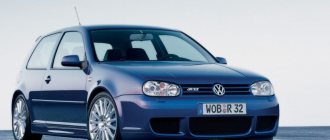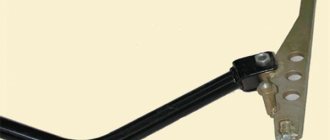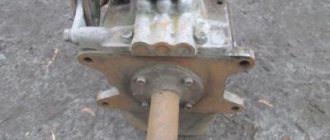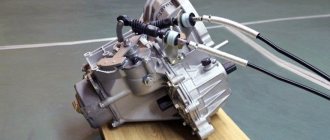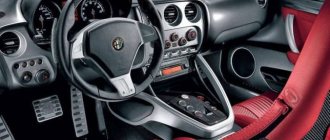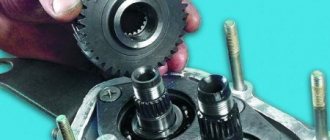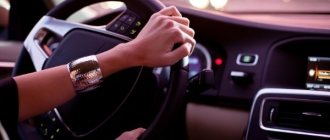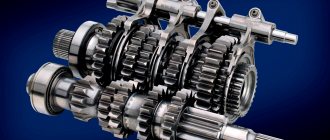The modern automobile market is diverse and multifaceted. All cars have long begun to differ not only in the type of engine and clutch, but also in the design of the transmission. The most common is the manual transmission, but the automatic transmission closely competes with it.
You can hear various arguments from car enthusiasts about which gearbox is better, what are the advantages and disadvantages of each of them. But what if you create an ideal symbiosis of two checkpoints? Take the best from “mechanics” and “automatic” and create a car with a perfect transmission. Until recently, this was considered unrealistic.
The history of the dual-clutch transmission
The first thoughts about how to create a continuous connection between a car engine and transmission came to Adolf Kegress back in 1939. But due to lack of funds, the invention was not translated into reality, but remained on paper. With the development of motorsport, when a racing car needs to quickly change gears without losing power and connection with the wheels, engineers at German automakers had to dig up their archives. Find and improve the Kegress development.
The dual-clutch transmission experienced its baptism of fire at the famous Monza race. The Porsche 962 equipped with this gearbox left no chance for its competitors. The time to switch gears took tenths of a second. And this without loss of power.
Principle of operation
The principle of operation of the clutch is based on a rigid connection between the clutch driven disc and the engine flywheel due to the frictional force generated by the force created by the diaphragm spring. The clutch has two modes: “on” and “off”. Most of the time the driven disk is pressed against the flywheel. Torque from the flywheel is transmitted to the driven disk, and from it through a splined connection to the input shaft of the gearbox.
Diaphragm spring operation diagram
To disengage the clutch, the driver presses the pedal, which is connected to the fork by a mechanical or hydraulic drive. The fork moves the release bearing, which, by pressing on the ends of the petals of the diaphragm spring, stops its pressure on the pressure plate, and it, in turn, releases the driven one. At this point, the engine is disconnected from the transmission.
Box device
If you disassemble this gearbox and look at its structure, you will immediately notice that the dual-clutch gearbox consists of two classic “mechanics”. The double shaft is the main working body of the device. Actually, why is the gearbox called double clutch? This is because in it one clutch transmits torque to the first (external) shaft, and the second transmits energy to the internal shaft. The outer shaft is responsible for even gears, and the inner one for odd ones. But there is no clutch pedal, and the mechanism is controlled electronically and hydraulically, as in an automatic transmission.
All this allows you to change gears comfortably and smoothly, without jerks or difficulties. There is no loss of power and continuous communication with the engine is ensured. There are some similarities with an automatic transmission, but the dual clutch operates without a torque converter. All the painstaking work is performed by a “wet” multi-disc mechanism.
Mechanism design
To become more familiar with the presented unit, it is necessary to study the structure of the mechanism itself, which ensures smooth gear shifting.
Unlike all other types of clutch, this type is distinguished by the presence of a number of unique components and elements.
So, this system includes the following key components:
- friction disc package;
- housing with dry or oil sump;
- mechatronics
If the first two nodes are quite familiar to car enthusiasts, then the third gives the impression of something hitherto unknown.
So, mechatronics is a high-tech clutch unit that allows you to convert electrical signals into the mechanical operation of actuator units.
Related article: Lambda probe, what is it, signs of malfunction and methods of checking
The mechatronics of a modern car, as a rule, includes two components: an electromagnetic unit and a control board.
The first is a set of solenoid valves, so-called solenoids. Previously, instead of solenoids, hydraulic distribution mechanisms, the so-called valve blocks, were used. But due to their low performance, they were replaced by more advanced electromagnetic devices.
Let's look at the fundamental features of wet and dry clutches.
"Wet" double
If we take an excursion into the history of the node in question, then the so-called “wet type” is considered to be the progenitor of the double node.
It is a set of two sections of ferodo discs immersed in an oil bath in the clutch housing.
In this case, it is customary to distinguish between two types of “wet clutch” depending on the type of vehicle drive. So, for front-wheel drive cars, a clutch with a concentric arrangement of ferodo discs is used. For owners of rear-wheel drive cars, the peculiarity of this device is manifested in the parallel arrangement of the driven disks.
This is interesting: 5 of the best car speakers for high-quality sound
The components of both types of “wet clutch” are the same. These include:
- inlet flange;
- main flange;
- drive disk;
- package of first and second order friction discs;
- diaphragm spring, auxiliary spring;
- plunger;
- hydraulic cylinders;
- input shaft of the first and second order.
"Dry" double
In addition to the “wet” clutch, there is also a so-called “dry” clutch. It cannot be said that it is worse or better than the previous one. In this case, it would be appropriate to emphasize that each of them is effectively used in the operating conditions provided for them.
Unlike the previous type, the design feature of the “dry” clutch does not require the use of lubricants. The driven disks are directly engaged with the input shafts of each gearbox.
For your information: How to make a foam generator for a car wash with your own hands
The working elements of such a mechanism include:
- input shafts;
- release bearings;
- friction discs;
- drive disk;
- two auxiliary disks;
- flywheel;
- diaphragm springs.
This design is designed to transmit less (as opposed to “wet”) torque, due to the low heat transfer coefficient.
However, due to the absence of the need to use an oil pump, which inevitably leads to power losses, the efficiency of this type of coupling is significantly superior to the previously considered variety.
Operating principle of the gearbox
Switching speeds is carried out by intuitively determining various factors electronically, namely:
- The position of the accelerator is determined. Based on this, the electronics concludes that acceleration or braking is occurring;
- The speed of rotation of the car wheels is determined;
- Number of revolutions of transmission shafts.
All this can be explained as follows: as soon as the car starts moving in first gear, the system prepares the next one. The first clutch opens, which forces the second to close. There is a moment in the operation of the gearbox when both mechanisms are in a closed position, but this only takes hundredths of a second. During this time, there is no loss of torque.
The video shows the operating principle of a double clutch transmission (DSG):
This creates a dynamically ideal vehicle movement. The most popular dual-clutch transmission today is considered to be a device from BorgWarner. The company works closely with the automotive giant Volkswagen. Prestigious cars are equipped with this type of dual-clutch gearbox. The development from Getrag is considered the most environmentally friendly; their transmissions contribute to the emission of a tiny amount of carbon dioxide into the atmosphere.
The design and principle of operation of a car clutch
A clutch is a transmission mechanism that transmits torque from the engine to the gearbox through friction. It also allows you to briefly disconnect the engine from the transmission and reconnect them smoothly. There are quite a few types of clutches. They differ in the number of driven disks (single disk, double disk or multi-disk), the type of operating environment (dry or wet) and the type of drive. Different types of clutches have their respective advantages and disadvantages, but the most common on modern cars is the single-plate dry clutch, either mechanically or hydraulically driven.
Advantages and disadvantages
According to many automotive experts, cars equipped with dual-clutch transmissions will soon reach a new level and take a strong position in the market. Since such transmissions differ:
- Smooth running, dynamic, constant connection with the engine;
- Increased fuel economy;
- Gear shifting in two modes: manual or automatic;
- There is no need for re-gasping or double squeezing.
All these advantages have become a viable solution to many problems for racing cars, where the cost of time is too high. But for public vehicles, in addition to the advantages, such a gear shift device will bring some difficulties for the owner, due to:
- Complexity of the mechanism;
- Expensive maintenance and repairs;
- Lack of specialized services.
The mechanism is very complex in its design. In addition, the gearbox has not become widespread in Russia, therefore, finding an understanding specialist today who could carry out high-quality repairs of the mechanism is very difficult. But in the future, most likely, the situation will change dramatically.
The bigger, the better
A modern “robot” with two clutches shows excellent results in terms of shift speed, but its spread is primarily due to reduced fuel consumption. According to the VW concern, using the example of a Golf with a 122-horsepower TSI engine, the version with DSG consumes on average 8.7% less gasoline than a similar one with a conventional “mechanics”. And compared to a hydromechanical “automatic machine,” the “robot’s” gain reaches an impressive 22%. Reducing fuel consumption means increasing environmental performance - the less fuel a car burns, the less carbon dioxide and toxic substances it emits. Improving the environmental friendliness of a car is a very fashionable topic now, and one of the ways to achieve success in this direction is to increase the number of steps. This trend has not bypassed dual-clutch transmissions. Seven gears is no longer considered “a lot”. While VW decided that there was no point in developing a 10-speed DSG, Acura still created a nine-speed one for the NSX sports coupe. Moreover, Honda has patented an 11-speed gearbox with three (!) clutches, probably hoping to achieve super-green performance in the future.
"Wet" double
There are two types of clutch, dry and wet (also multi-plate in oil). The so-called “wet” has better cooling. Most often it is installed on gearboxes with a torque of 250 Nm and above. An example would be the Bugatti Veyron, whose torque reaches 1250 Nm.
The second set of discs is mounted on separate hubs, which are located on the input shaft of the corresponding row of gears. In the normal position the mechanism will be open. As for the closure, this is done thanks to hydraulic cylinders controlled by an electrohydraulic module. The disks take their initial position due to springs.
Depending on the design of the double clutch, the friction disc packs can be arranged differently, concentrically or parallel. Concentrically, when the couplings are located in the same plane and perpendicular to the input shaft. In this position the couplings are more compact. Typically used in gearboxes with front-wheel drive and a transverse engine. As a rule, the internal clutch is responsible for shifting even gears, and the external clutch is responsible for shifting odd gears. It becomes clear that such a set is designed to transmit high torque.
Parallel - when the couplings are located one behind the other. As a rule, this arrangement is used for rear-wheel drive cars.
Double clutch on a Ford
It is called Power Shift and has been installed on cars since 2007. Other companies that also use this transmission include Volvo, Jaguar, and Mazda. The 6DCT450 clutch is “wet”. If the faults are minor, they will repair it without removing it. The cost of work in this case is from 15 to 19 thousand rubles. Dismantling the checkpoint and installing it will add another 11 thousand. The final cost depends on the parts being replaced. But if you decide to change the clutch assembly, a complete set, for example, on YandexMarket, will cost 75-90 thousand rubles.
Installing a clutch on a Ford Focus. Photo: Youtube. com.
Graphic diagrams of wet and dry clutches
Wet double clutch diagram:
- Input hub;
- Clutch hub first;
- Clutch hub second;
- Leading disk;
- Clutch disc pack second;
- First clutch disc pack;
- Diaphragm spring;
- Piston;
- Hydraulic cylinder of the first clutch;
- Primary shaft for row 1;
- Primary shaft for row 2;
- Main hub;
- Piston;
- Coil spring;
- Second clutch hydraulic cylinder.
Dry double clutch diagram:
- input shaft 1;
- release bearing 2;
- diaphragm spring 2;
- pressure plate one;
- master disk;
- dual-mass flywheel;
- clutch disc 2;
- pressure plate 2;
- clutch disc 1;
- diaphragm spring 1;
- release bearing 1;
- input shaft 2.
Video of how the S-Tronic system works on Audi:
Source of the article: https://fastmb.ru/auto_shem/1038-dvoynoe-sceplenie-opisanie-i-princip-raboty.html
Type of mechanisms
The double clutch, as is already clear, works in concert with the gearbox. In dual-clutch automatic transmissions, different clutches are used for odd and even gears. We can say that, in essence, these are two different boxes that are located in the same case and work as one whole.
The use of a double clutch was first mentioned in 1980 by Audi and Porsche, which used their designs for their own sports cars. Nowadays it has migrated to production models and is called:
This is not yet a complete list of manufacturers who use similar technology for their cars.
Despite the name of the automaker's company, it is completely different. Due to the complexity of the technology of operation of such a mechanism, manufacturers are distinguished:
It often happens that automakers combine spare parts and individual systems from different manufacturers. For example, BMW uses a double clutch from BorgWarner and a gearbox from Getrag.
Pros and cons of dual-clutch robotic transmissions
Let's start with the advantages :
- efficiency is one of the main advantages of these transmissions, and it is worth noting that fuel consumption rates on versions with a dry clutch are lower than on wet ones;
- smooth ride. Due to the peculiarity of shifting gears, which go one after another, it was possible to completely get rid of the slight jolts that are inherent in a classic automatic;
- dynamics;
- ability to select the transmission operating mode;
Now let's talk about the disadvantages
- one of the main ones is the unreliability and failure of mechatronics. This is mostly a problem with the DSG-7;
- expensive to repair and maintain;
- sensitive to difficult road conditions.
- metallic clanging when driving over speed bumps or bumps (we're talking about DSG-7)
- the cost of producing a robotic transmission with two clutches is quite expensive.
